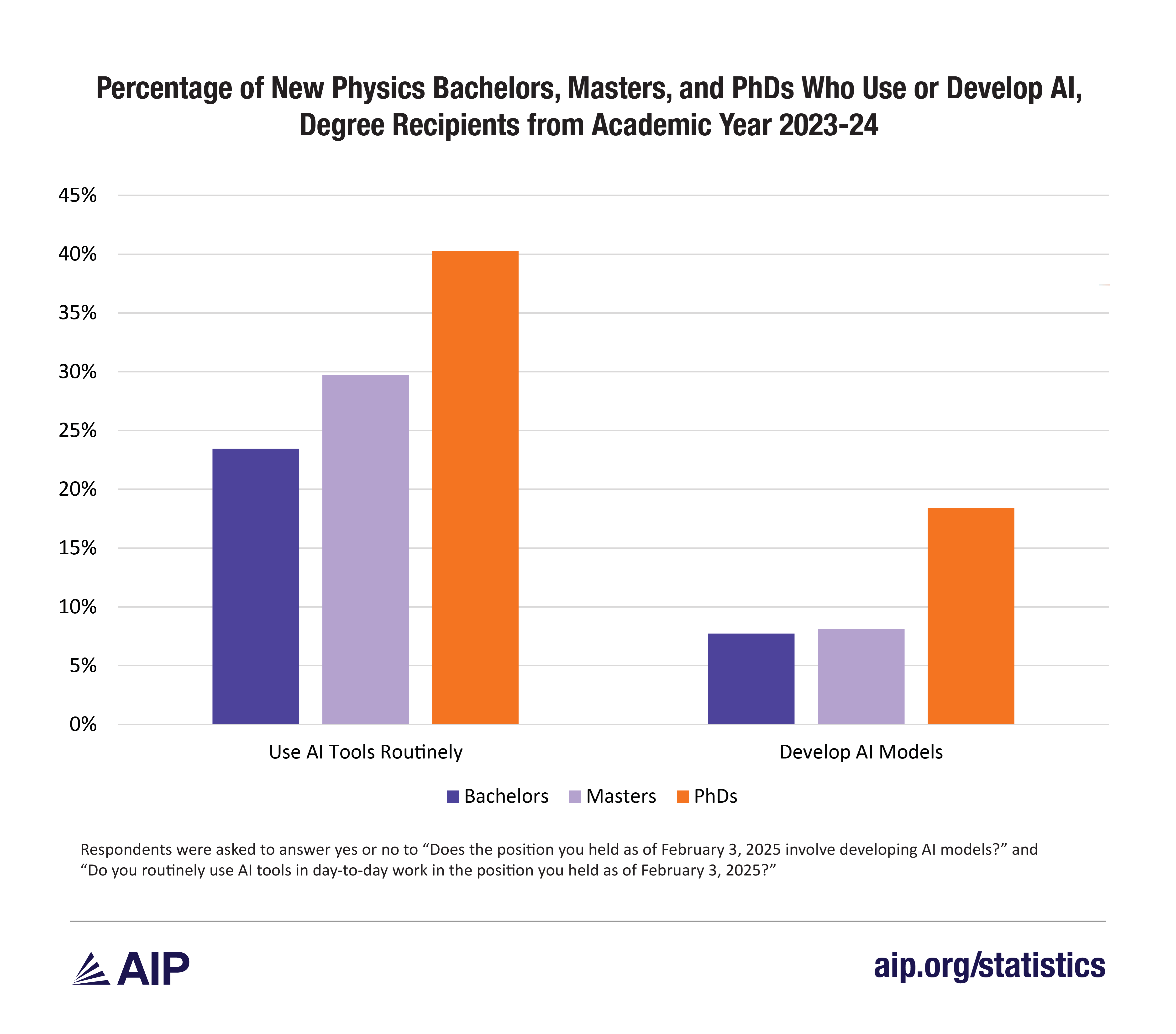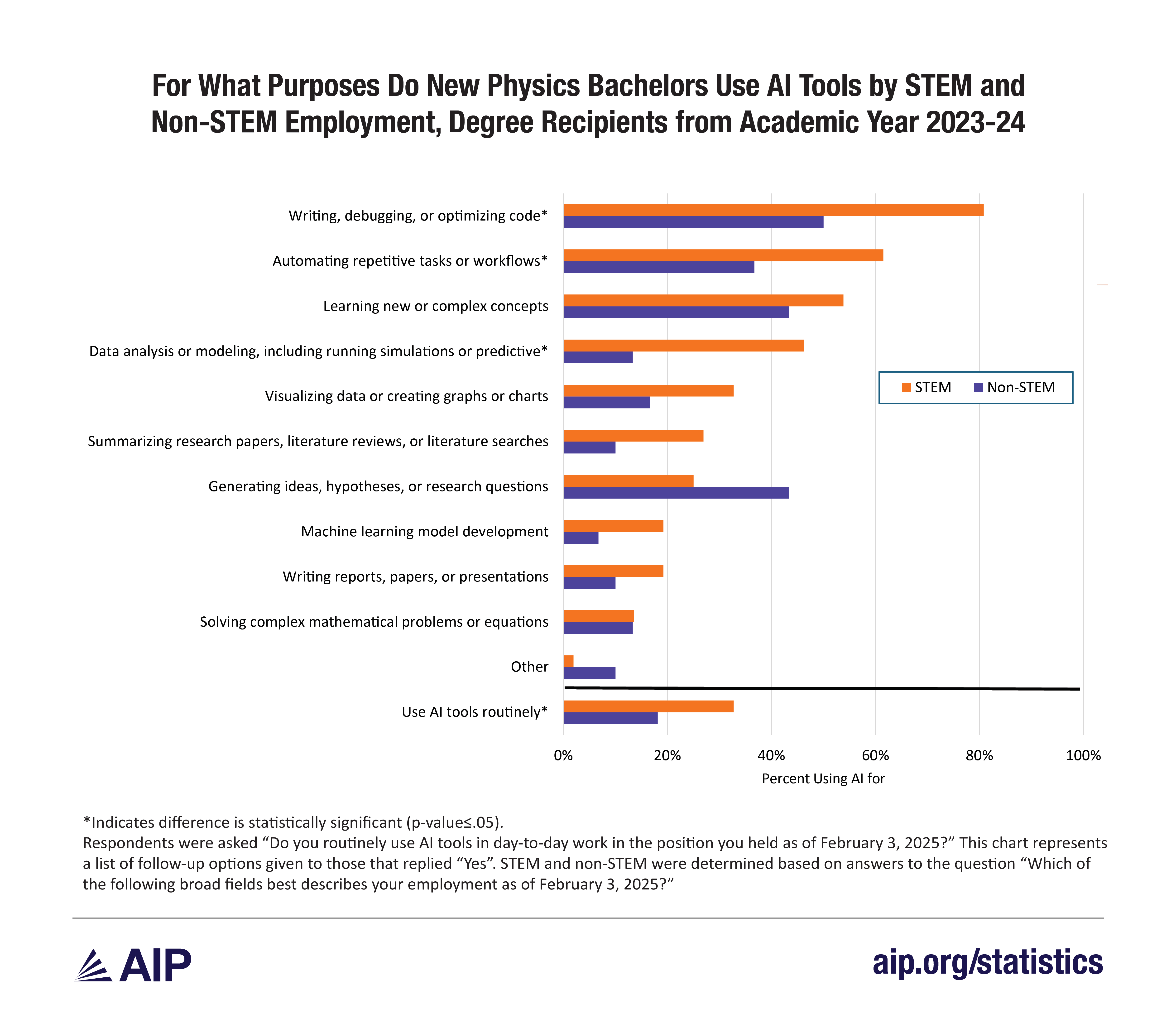AI Use Among Physics Degree Recipients
Artificial intelligence (AI) is emerging as a transformative force across industries, including the physical sciences. Indeed, as the 2024 Nobel Prize in physics awarded to John Hopfield and Geoffrey Hinton for their work on artificial neural networks shows, physicists have been making foundational contributions to AI development for decades (AIP, 2024
According to an Insights 2024: Attitudes toward AI survey of people working in research (including leaders and corporate researchers) and as health clinicians found awareness of AI was high, but usage was still generally low. Respondents were concerned that AI had the potential to spread misinformation, make critical errors, and cause disruption to society. At the same time were optimistic and could foresee a range of benefits from AI. Such benefits included: accelerating knowledge discovery, rapidly increasing the volume of scholarly and medical research, and providing cost savings to institutions and businesses (Elsevier, 2024
To begin examining its impact on the physics community, AIP integrated AI-specific questions into its annual Degree Recipient Follow-Up Survey. This report presents findings on how recent physics degree recipients are engaging with AI, encompassing both its development and its application in daily professional activities.
AI Usage and Development
New physics degree recipients in the workforce interact with AI in two distinct, and sometimes overlapping, ways: by developing and training AI models, or by using existing AI tools to assist with their work.
Across all degree levels, respondents were far more likely to report routinely using AI tools than developing AI models (Figure 1). New physics PhDs were twice as likely as master’s and bachelor’s recipients to develop AI models in their post-degree positions. The prevalence of routine AI usage increases with degree level; twenty-three percent of bachelor’s recipients indicated they regularly use AI tools in their work, compared with 40% of PhD recipients.
Figure 1

Bachelor’s Degree Recipients
Overall, new physics bachelor’s recipients employed in STEM (science, technology, engineering, and mathematics) fields were more likely to regularly use AI tools than those working in non-STEM fields—33% versus 18%, respectively (Figure 2).
When we asked users about the purposes for which they use AI tools, STEM-employed bachelor’s recipients reported a broader range of uses than their non-STEM counterparts—with a median of 3.5 regular uses compared to 2.5 for non-STEM respondents. Regardless of field of employment, the most common use of AI tools was writing, debugging, or optimizing code. The only category where non-STEM respondents reported more frequent use than those in STEM was generating ideas, hypotheses, or research questions.
Figure 2

Examples of AI Usage for New Physics Bachelors
“Currently working on computer vision models for various applications in the semiconductor industry”
“I create AI models to predict weather and create applications to inform others of natural disasters.”
“Develop and train convolutional neural network for computer vision identification of objects”
“AI software can be helpful in developing success criteria for students regarding a certain learning goal”
PhD Recipients
About two-fifths of new physics PhDs, whether employed in potentially permanent positions or postdoctoral appointments, reported routinely using AI tools in their day-to-day work (Figure 3).
AI users in potentially permanent positions used them for a wider range of purposes than postdocs, with a median of 4 regular uses compared to 3 among postdoctoral appointees. As with physics bachelor’s recipients, the most common use of AI tools was writing, debugging, or optimizing code, regardless of employment type. PhDs in potentially permanent positions were more likely than postdocs to report using AI tools for machine learning model development and generating ideas, hypotheses, or research questions.
Figure 3

Examples of AI Usage for New Physics PhDs
“Broadly speaking, I am developing AI models to accelerate progress in particle physics”
“I develop camera-based detection models for autonomous vehicles”
“I develop large AI models to estimate distances to galaxies. I also worked on making the results from these models trustworthy”
“Using quantum inspired techniques to develop new AI models and algorithms”
Survey Methodology
Each fall AIP conducts a Survey of Enrollments and Degrees, which asks all degree-granting physics and astronomy departments in the US to provide information concerning the number of students they have enrolled and counts of recent degree recipients. At the same time, they are asked to provide the names and emails of recent bachelor’s degree recipients. We then use this degree recipient contact information to conduct our follow-up survey in the winter following the academic year in which students received their degrees. The data in this report comes from that survey of physics degree recipients from the 2023-24 academic year. The findings in this report are based on information from: 439 Bachelors, 37 masters, and 263 PhDs.
Specific AI uses for physics masters are not included in this report due to an insufficient number of respondents.
References
American Institute of Physics. (2024). AIP Congratulates 2024 Nobel Prize Winners in Physics. Retrieved at
https://www.aip.org/aip/celebrating-2024-nobel-physics-prize
Elsevier. (2024). Insights 2024: Attitudes toward AI. Retrieved at
https://www.elsevier.com/insights/attitudes-toward-ai









